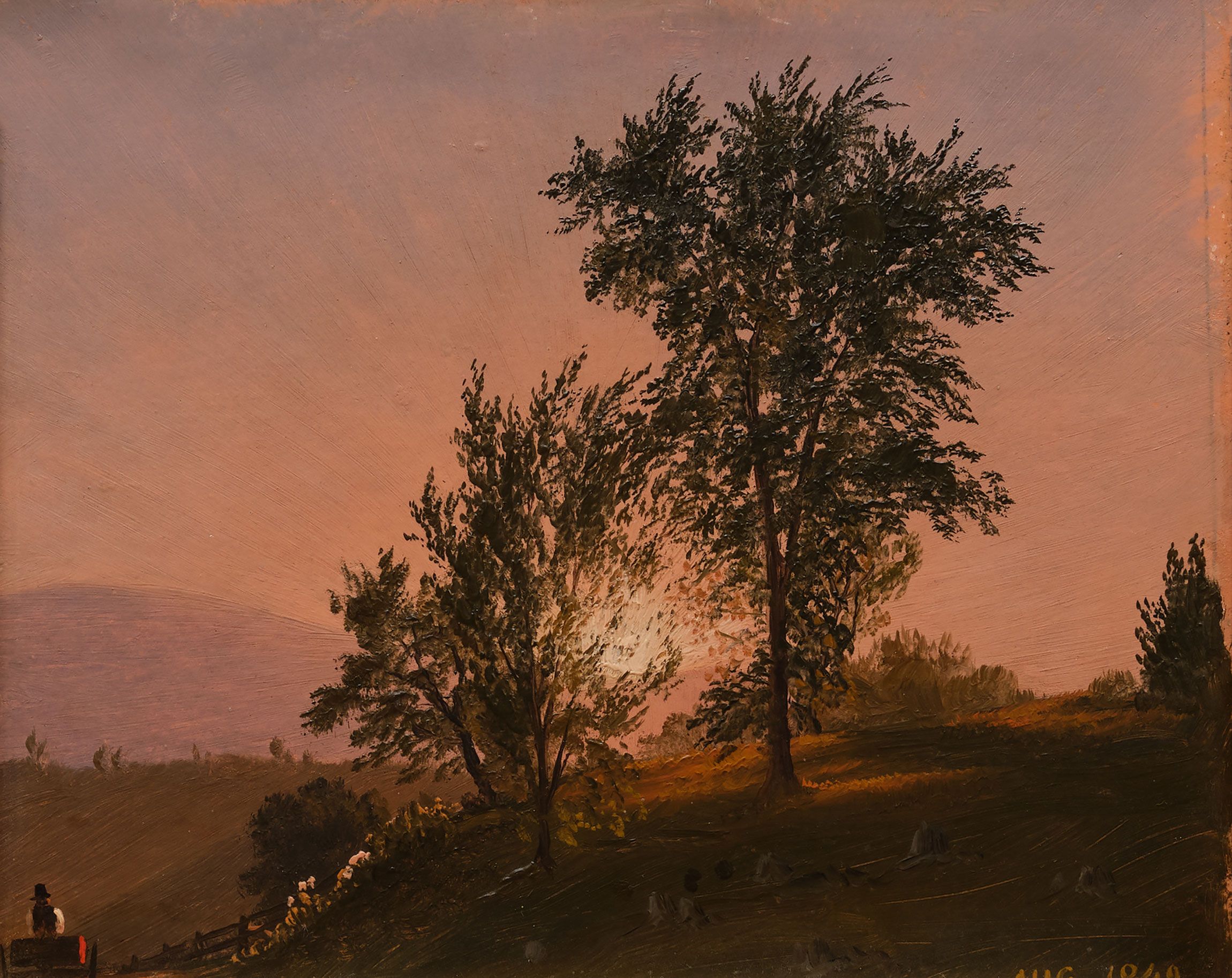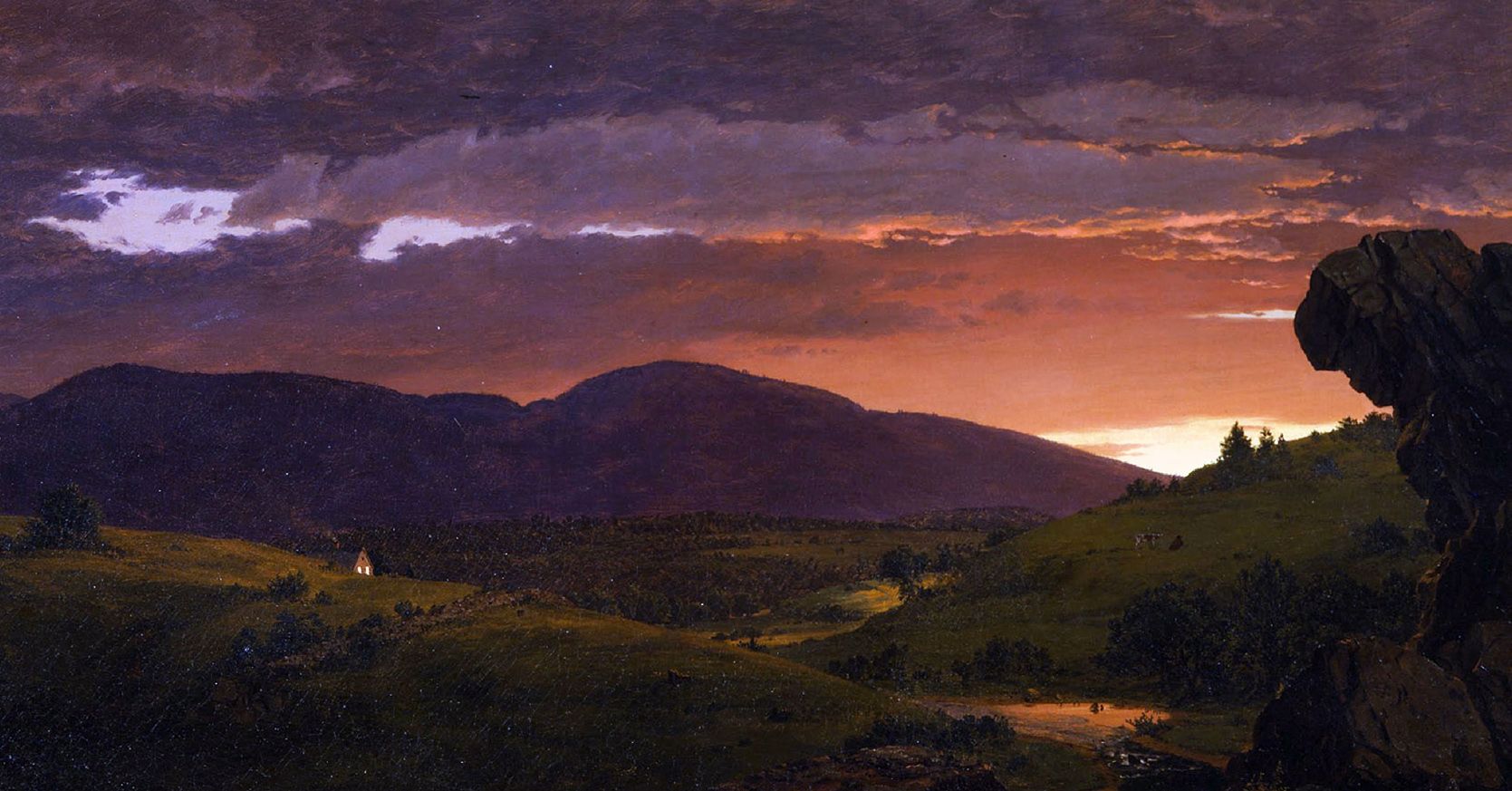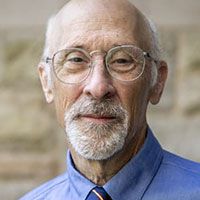
Frederic Edwin Church (1826–1900)
New England Landscape, 1849
Oil on canvas
McMullen Museum of Art, Boston College, Carolyn A. and Peter S. Lynch Collection, 2022.43

Oliver Wunsch
Assistant Professor, Art History

The twenty-three-year-old Frederic Edwin Church spent the summer of 1849 in New England, settling in the region of Cuttingsville, Vermont.1 This jewel-like study of a hilly field at sunset was likely made in the area. The painting’s diminutive size belies Church’s larger ambitions. Having recently become one of the youngest painters ever elected to New York’s National Academy of Design, he spent his time in Vermont producing small studies to incorporate into larger canvases that he would exhibit in New York the following year.2 Among the most important of these works were two paintings of sunsets over Vermont meadows: Ira Mountain, Vermont and Twilight, “Short Arbiter ’twixt Day and Night” (both shown here). Neither picture corresponds exactly to this study in its composition. What they share is Church’s attention to the spectacular effects of the sun’s passage over the horizon, when the sky sets itself ablaze and transforms terrestrial bodies into shadowy silhouettes.
1. David Carew Huntington, “Frederic Edwin Church, 1826–1900: Painter of the Adamic New World Myth” (PhD diss., Yale University, 1969), 24.
2. Franklin Kelly, Frederic Edwin Church (Washington, DC: National Gallery of Art, 1989), 43.


Paul Lewis
Professor, English

This small painting invites us into a sun-soaked world of sloping fields and a few trees. On the lower left, a farmer is driving a wagon along a fence line behind a group of sheep. At the spatial and thematic center, the sun illuminates the landscape from behind and the sky from below. Most likely focused on the task at hand, the farmer is nonetheless headed up toward and almost into the sun. The word “sun” appears over a hundred times in Thoreau’s Walden; or, Life in the Woods (1854), including in this passage from the “Economy” chapter that Church’s landscape brought to mind:
To anticipate, not the sunrise and the dawn merely, but, if possible, Nature herself! How many mornings, summer and winter, before yet any neighbor was stirring about his business, have I been about mine! No doubt, many of my townsmen have met me returning from this enterprise, farmers starting for Boston in the twilight, or woodchoppers going to their work. It is true, I never assisted the sun materially in his rising, but, doubt not, it was of the last importance only to be present at it.
Gregory Fried
Professor, Philosophy

When Church painted this small landscape in August of 1849, he was only twenty-three years old, but he was already three years out from a two-year apprenticeship with the landscape painter, Thomas Cole (1801–48). With Cole, he had toured the Catskills of New York and the Berkshires of Massachusetts to sketch vistas for studio work; this scene evokes rural New England. It is at once very unlike Church’s famous mature paintings, yet nevertheless hints at his late work. First, it looks as if it were painted on scene, not worked up in the studio using sketches, as was Church’s norm. It has an immediacy and an intimacy absent from his famous grand landscapes. A naivete in Church’s brushwork here fits the modest, rural world of Yankee farmers. Yet, a blinding burst of sun threatens to immolate the scene, overwhelming the purple-gray hill in the distance, its late summer light held at bay only by small trees in the foreground. Church’s brushwork accentuates the sunburst with long, linear strokes that radiate from the focal point. The tiny figure riding away in his wagon, almost certainly a farmer given his white shirt and black vest and tall, wide-brimmed hat, seems both oblivious to and unaffected by the sublime, overwhelming sun-stroke and his wagon catching an unappreciated red lick of light on its side.
By the late 1840s, Church was falling under the influence of the German naturalist and philosopher, Alexander von Humboldt (1769–1859), who challenged artists to travel widely from home to give witness to the world’s glories. Within ten years, Church’s massive canvasses of majestic scenes would win him glory in America and Europe. Those later paintings cudgel viewers over the head with their monumental visions; this one invites them not to ignore the transcendent present amid the normalcy of nature, on a scale any of us could hang on our wall. Like the aptly named transcendentalists, such as Ralph Waldo Emerson (1803–82) and Henry David Thoreau (1817–62), who were establishing their voices as writers in this decade, here Church wanted to illuminate the experience of awe in the nearness of the everyday in nature.
